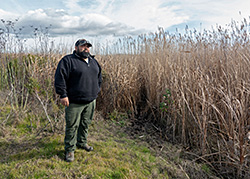
Rocha manages the nearly 17,000-acre Grizzly Island Wildlife Area (GIWA) in Solano County.

GIWA offers seasonal hunting opportunities for waterfowl, tule elk and wild pigs.
Orlando Rocha is CDFW’s environmental scientist for the Grizzly Island Wildlife Area (GIWA) in Solano County. His main role is ensuring that there is suitable habitat for the fish, plant and wildlife species that inhabit the nearly 17,000-acre wildlife area. His day-to-day job includes habitat management planning, coordinating wildlife surveys, managing permits and overseeing hunt programs. Additionally, he is responsible for partnering with agencies and nonprofits for research, management and wildlife conservation projects.
Rocha began volunteering at CDFW’s American River Hatchery when he was a junior in high school and was later hired to work weekends. He then attended Humboldt State University where he earned a degree in wildlife management and conservation. After graduating, Rocha worked part-time as a scientific aid for CDFW until he was hired as a biologist for the Suisun Resource Conservation District. He was hired by CDFW as GIWA’s biologist in 2013.
What inspired you to become a scientist?
When I was about 11 years old, my dad and I were fishing at Ice House Reservoir when a U.S. Forest Service officer rode up on a dirt bike to talk to us. I was shocked that you could do that as a job, so that may have been my first inspiration. But I’ve wanted to work outdoors for as long as I can remember. My birthday is in July and growing up all I ever wanted to do for my birthday was go camping. Once I started volunteering at the hatchery during high school, I found that all my colleagues were good people. They were fun to be around and seemed to like the work they were doing. One of the hatchery employees told me I needed to go to Humboldt State University if I wanted to become a biologist for CDFW, so that’s exactly what I did!
What’s the most challenging part of your job?
Definitely time management. There’s always something to do at GIWA, which is nice but also one of the toughest aspects of the job. There’s a lot to keep our eyes on – from checking water levels in our ponds to completing surveys, serving visitors and preparing upcoming hunt programs for waterfowl, tule elk or wild pigs. But it’s also a good thing because I’m never bored.
What would you like people to know about GIWA?
Many people see GIWA as they drive by on Highway 680 or Highway 12, but they may not realize how many wildlife populations we have here. There are many species of birds that migrate in and out. In addition to waterfowl, we have northern harriers, black-necked stilts, American avocets, great horned owls, eagles and more. Recent studies have shown that many of our birds migrate from as far away as Canada, Alaska and Montana. In addition to birds, we have one of the most visible tule elk herds in California. There’s all this great wildlife to see if you visit us, and our main office is only nine miles from Highway 12.
What’s your biggest career accomplishment so far?
I’d say the partnerships formed with other agencies and non-profits that help us keep improving our water management and habitat. I’m currently working with the California Waterfowl Association on a proposal that is funded through the sale of duck stamps. The project will help GIWA in two ways: First, it will help ensure a more reliable water source for the closed zone at GIWA. Closed zones are an important part of wildlife areas that provide sanctuary where wintering migrant birds can go to be undisturbed. Second, the project will include levee repair and the installation of new water control structures which will allow us to improve wildlife habitat by providing additional water control in four of our most popular hunting units.
What advice do you have for young people who are considering careers in science or natural resources?
The biggest thing is experience. Schooling is great, and you can’t go wrong continuing your education by getting a master’s degree or Ph.D. But if you and another job candidate have the same educational background, it’s your experience that will get you the job. Get experience any way you can, whether it’s at your local hatchery or wildlife area or volunteering to plant trees for a nonprofit. At GIWA, we occasionally have students help with our elk surveys. From a certain perspective, all we’re doing is counting elk from a truck. But from another perspective, the volunteer is learning survey protocol, and that’s the type of experience that will help them get ahead of the competition.
Networking is important too. During my first year at Humboldt State University, I just went to class, came home and hung out with my roommates. It was kind of boring. Then I decided to join the wildlife club on campus and spend more time networking with people who wanted careers in conservation. I’m still friends with a lot of those people. Now we work for various wildlife agencies and organizations and support each other in the work we do.
What would you be doing if you weren’t a biologist?
I like working with my hands. If there was no such thing as a wildlife biologist, I would probably be a gunsmith or a butcher.
CDFW Photos. Top Photo: CDFW Environmental Scientist Orlando Rocha
Media Contact:
Ken Paglia, CDFW Communications, (916) 322-8958